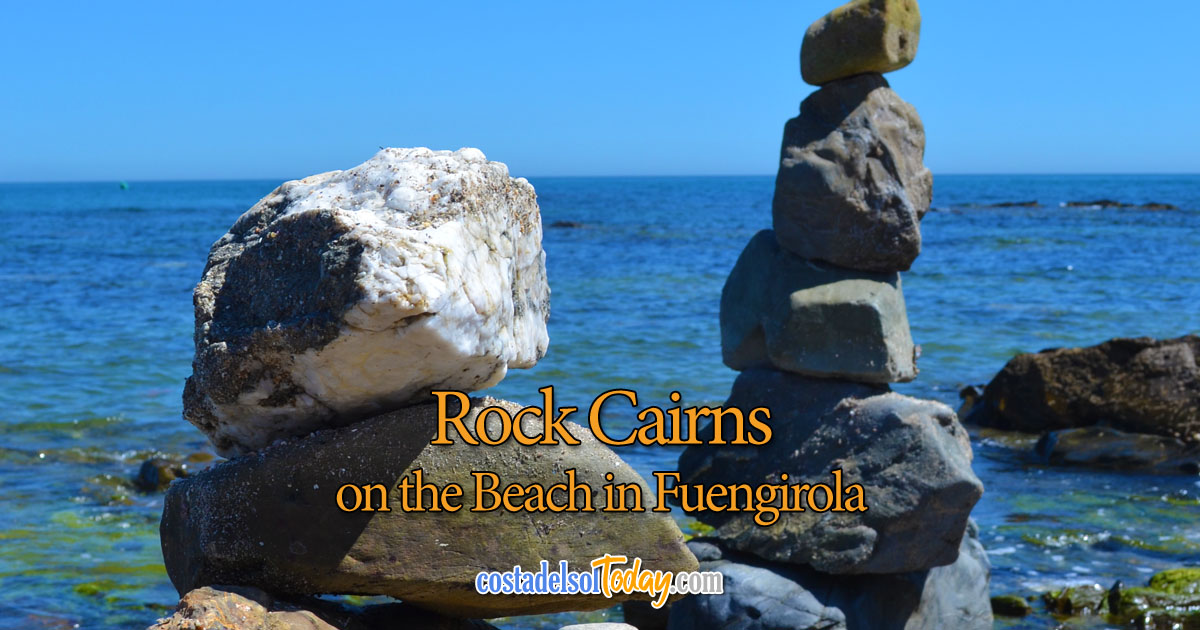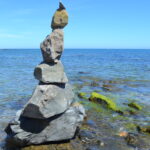Rock Cairns on the Beach in Fuengirola. Stones and rocks piled up on the seafront by visitors into small cairns. Are they nomadic markers? Are they burial mound markers? Most likely not. They’ve probably been been built by tourists. They’re pretty, though.


Rock Cairns on the Beach in Fuengirola
A cairn is a man-made pile (or stack) of stones raised for a purpose, usually as a marker or as a burial mound. The word cairn comes from the Scottish Gaelic: “càrn”.
Cairns have been – and still are – used for a broad variety of purposes. In prehistoric times, they were raised as markers, as memorials and as burial monuments (some of which contained chambers). In modern times, cairns are often raised as landmarks, especially to mark the summits of mountains. Cairns are also used as trail markers. They vary in size from small stone markers to entire artificial hills, and in complexity from loose conical rock piles to elaborate megalithic structures. Cairns may be painted or otherwise decorated, whether for increased visibility or for religious reasons.

- Banksy in Fuengirola? Banksy in Fuengirola? Most likely, no, but this picture stenciled on a wall on 'Fish Alley' certainly looks like a Banksy. A smiling chimpanzee sticking bananas in his or her ears is a notable diversion from the endless tourist bars and restaurants.
- Fuengirola Promenade (El Paseo) Fuengirola Promenade (El Paseo). Nestled along the sun-kissed shores of the Costa del Sol in southern Spain lies the picturesque town of Fuengirola, renowned for its stunning beaches, vibrant culture, and laid-back atmosphere.
- Rock Cairns on the Beach in Fuengirola Rock Cairns on the Beach in Fuengirola. Stones and rocks piled up on the seafront by visitors into small cairns. Are they nomadic markers? Are they burial mound markers? Most likely not. They've probably been been built by tourists. They're pretty, though.
- Rocket to the Moon, from Cape Fuengirola Rocket to the Moon, from Cape Fuengirola. The gleaming tower stretches for the clear blue sky as a place flies by, presumably going to or just leaving Málaga Airport. If there's one thing almost guaranteed about Spain's southern coast, it's the fantastic blue skies.
- Sohail Castle, Fuengirola Sohail Castle, or Fuengirola Castle, towers above the main A7 motorway as you enter Fuengirola from the west. An imposing fortified structure dating back centuries, the castle and grounds are now a tourist attraction and event venue.
Are these cairns on the beach at Fuengirola markers, or burial grounds? Very probably not. They are most likely built by excited tourists to the town. Still, they are nice and make for an unusual sight for the casual wanderer, strolling the beaches of Fuengirola.
What are those piles of stones on the beach? During a walk along the sea front we saw “stone piles” in a couple of locations. These were impossibly balanced stones making odd looking sculptures. What are they and why do people build them? ( And perhaps most interestingly how do they stay up!) Anyone know?
They have them in Playa Blanca, several guys build them as a tourist attraction, basically as a source of income (collection in a hat). I spoke to one of the guys who told me they only use materials from the beach. I was told they are built as ‘temples of peace’ for people lol
Originally the piles of stones appeared in various parts of Europe to denote that a person had achieved a walk eg climbing on a volcano etc. Costa Adeje on Tenerife was the first I saw of them in great numbers on the beach but have seen them in quite a few other places on walks
Stone Stacks
The balancing of stones is an elementary kind of creation, rather like the building of sand castles. Stone stacks, or cairns, have prehistoric origins. They marked Neolithic burial grounds in what is now Scotland, guided nautical travels in Scandinavia, and served as shrines to the Inca goddess Pachamama in Peru. Contemporary stone stackers, then, are taking up the mantle of an ancient and artistic tradition. In the past decade or so, though, there has been an explosion of cairns around the world—in national parks, in the Scottish Highlands, on the beaches of Aruba. Park rangers, environmentalists, and hikers have all become alarmed, to varying degrees. The movement of so many stones can cause erosion, damage animal ecosystems, disrupt river flow, and confuse hikers, who depend on sanctioned cairns for navigation in places without clear trails.

Fuengirola Beach
Andalusia offers many beach resorts on the Costa Del Sol. Málaga, Torremolinos and Marbella are the ones you always hear. Fuengirola Beach is also one of the most popular resorts. It is the haven for the people who escape the freezing winter. With a 7 kilometer long coastline, a great nightlife and a rich history, there is something for every tourist and house seeker.
Playa El Ejido: Well-known for the Moorish castle Sohail, which is located right behind the beach.
Playa de los Boliches: This one has been described by many tourists as the best beach in Fuengirola. It has not been given the ‘blue flag’ for no reason (a quality mark for a beach or coastline that meets certain standards, for example, water quality, high environmental, etc.).
Playa de San Francisco: Best known for the harbor where it is located. There are plenty of facilities such as water sports, shops and restaurants. Spread over about 350 meters.
[footerblock]






